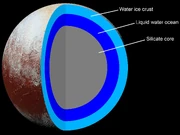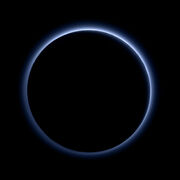Pluto, minor planet designation (134340) Pluto is the second closest dwarf planet to the Sun, formerly known as the ninth planet. It was discovered on February 18, 1930 by astronomer Clyde W. Tombaugh. It is the largest object in the Kuiper belt but less dense than Eris. It was originally referred to as the ninth planet, but was demoted into being classified as a dwarf planet in 2006.
Pluto's natural satellite, Charon, is half the size of Pluto. In fact, it is so big that Pluto orbits Charon too. But the IAU has yet to formalize a definition for a binary dwarf planet system, so Charon is classified as a satellite for now.
Moons
Main article: Moons of Pluto
Pluto has 5 natural satellites. Charon, Nix, Kerberos, Hydra, and Styx. Charon is half of Pluto's diameter.
Interior

Interior of Pluto (model 1)
The outer crust of Pluto is made of frozen nitrogen and water ice. Under the crust is either a frozen layer of water or liquid water. The final layer is the middle of Pluto, a silicate core.
Formation
Pluto was formed from a clump of rocky materials and particles around 4.5 billion years ago between the location of Neptune and Uranus.
It propelled to the edge of the Solar System during the Migration of Neptune event as Jupiter's and Saturn's gravity propelled Neptune towards the edge of the Solar System.
Surface
Not much is known about Pluto's surface.
Scientists theorize hydrocarbon atoms form when the Sun's light rays hit Pluto's surface, which could explain why Pluto's snow looks a bit reddish-brown. However, artist depictions describe Pluto's surface as being a bumpy place being made of rock. Pluto has numerous caverns and mountainous areas.
Atmosphere

Atmosphere of Pluto, taken by New Horizons.
Pluto does not have a significant atmosphere. It has a thin envelope of gas that is most likely made up of nitrogen, methane, and carbon monoxide, that develops in equilibrium with solid nitrogen and carbon monoxide ices on the surface as it approaches the Sun. As Pluto moves away from its perihelion (closest point to the Sun), more of its atmosphere freezes and falls to the ground. When it returns to a closer proximity to the Sun, the temperature of Pluto's solid surface will increase, causing the nitrogen ice to sublimate into gas—creating an anti-greenhouse effect. Much as sweat evaporating from the surface of human skin, this sublimation has a cooling effect and scientists have recently discovered, by use of the sub-millimeter array, that Pluto's temperature is 10 kelvin less than they expected.
Gallery
| Dwarf Planets and Dwarf Planet Candidates | ||
|---|---|---|
| Asteroid Belt | Consensus | Ceres |
| Possible | Hygeia • Vesta | |
| Centaurs | Possible | Chariklo • Chiron • 2013 TC₁₄₆ • 2014 NW₆₅ |
| Plutinos | Consensus | Orcus • Pluto |
| Possible | Huya • Ixion • 2001 QF₂₉₈ • 2002 VR₁₂₈ • 2002 XV₉₃• 2003 AZ₈₄ • 2003 UZ₄₁₃ • 2003 VS₂ • 2007 JH₄₃ • 2017 OF₆₉ | |
| Twotinos | Possible | 2002 WC₁₉ |
| Cubewanos and other Kuiper Belt Objects | Consensus | Haumea • Makemake • Quaoar |
| Possible (cubewanos) | Chaos • Salacia • Varda • Varuna • 1998 SN₁₆₅ • 2002 AW₁₉₇ • 2002 CY₂₄₈ • 2002 KX₁₄ • 2002 MS₄ • 2002 UX₂₅ • 2002 QW₉₀ • 2004 GV₄ • 2004 NT₃₃ • 2004 PF₁₁₅ • 2004 TY₃₆₄ • 2004 UX₁₀ • 2005 RN₄₃ • 2005 UQ₅₁₃ • 2010 FX₈₆ • 229762 Gǃkúnǁʼhòmdímà | |
| Possible (other) | 1999 CD₁₅₈ • 1999 DE₉ • 2000 YW₁₃₄ • 2002 XW₉₃ • 2010 JO₁₇₉ • 2010 VK₂₀₁ • 2011 FW₆₂ • 2011 GM₂₇ • 2013 FZ₂₇ • 2014 UM₃₃ • 2015 AM₂₈₁ • 2015 RR₂₄₅ | |
| The Planets and Dwarf Planets | |
|---|---|
| Planets | |
| Mercury • Venus • Earth • Mars • Jupiter • Saturn • Uranus • Neptune | |
| Dwarf Planets | |
| Ceres • Pluto • Haumea • Makemake • Quaoar • Eris | |
| Geology of Pluto | |
|---|---|
| Regions | Belton • Tombaugh "The Heart" • Lowell |
| Terrae | Hayabusa • Pioneer • Venera • Viking • Voyager |
| Maculae | "Brass Knuckles" (Krun • Ala • Balrog • Vucub-Came • Hun-Came • Meng-pʻo) • Cadejo • Morgoth |
| Hills and Mountains | Challenger Colles • Coleta de Dados Colles • Hillary Montes • Tenzing Montes |
| Plains | Sputnik Planitia |
| Valleys and Depressions | Quidlivun Cavus |
| Lineaea | Luna Linea |

